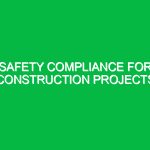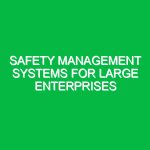In the realm of Health, Safety, and Environment (HSE), the phrase “Best Practices for Incident Prevention” encapsulates a proactive approach to managing risks and minimizing hazards. These practices are not only essential for safeguarding workers and the environment but also for promoting a culture of safety within organizations. With countless industries facing potential hazards every day, understanding and implementing these best practices can significantly reduce the frequency and severity of incidents.
Understanding Best Practices for Incident Prevention
Best practices in incident prevention refer to a set of guidelines, strategies, and protocols designed to identify, assess, and mitigate risks before they lead to accidents or incidents. These practices are grounded in thorough research, real-world applications, and regulatory compliance. They emphasize a culture of safety, where every employee feels responsible for their safety and that of their colleagues. In industries like construction, manufacturing, and healthcare, where risks are inherently high, adopting these practices can save lives and prevent costly damages.
Identifying Hazards and Risks
Recognizing potential hazards is the first step in effective incident prevention. Various types of risks can arise in different environments. Here are some common hazards associated with incident prevention:
Physical Hazards
These include slip and fall risks, machinery accidents, and exposure to harmful substances. For instance, in the construction industry, workers often face risks from heights, scaffolding failures, and moving vehicles. The Occupational Safety and Health Administration (OSHA) emphasizes the importance of fall protection systems to mitigate these dangers.
Chemical Hazards
Chemicals present in the workplace can pose significant health risks. Improper storage, handling, or disposal of chemicals can lead to spills, fires, or exposure that may cause long-term health issues. For example, in laboratories, strict adherence to Material Safety Data Sheets (MSDS) is crucial for proper handling of hazardous substances.
Biological Hazards
Workers in healthcare, agriculture, or laboratories often encounter biological agents, such as bacteria or viruses. The COVID-19 pandemic underscored the importance of understanding and mitigating these risks through proper hygiene practices and personal protective equipment (PPE).
Ergonomic Hazards
Workplace design can lead to musculoskeletal disorders if not properly addressed. For instance, an office worker may experience chronic pain due to poor ergonomics, which can ultimately result in absenteeism and reduced productivity. Implementing ergonomic assessments can help alleviate these risks.
Psychosocial Hazards
Stress, harassment, and burnout are increasingly recognized as significant hazards affecting workplace safety and productivity. A supportive work environment that prioritizes mental health can prevent these issues from escalating.
Safety Precautions and Best Practices
Once potential hazards are identified, developing safety precautions and best practices becomes crucial. Here are detailed strategies for effectively preventing incidents:
Conduct Regular Risk Assessments
Regularly evaluating the workplace for potential hazards is fundamental. Risk assessments should be systematic and involve input from various team members to identify both visible and hidden risks. For example, a manufacturing plant might conduct monthly safety audits to ensure compliance with safety standards.
Implement Training and Education Programs
Employees should receive comprehensive training on safety protocols relevant to their roles. This includes not only initial training but also ongoing education. For instance, a construction company could hold weekly safety briefings to keep staff updated on new safety measures and regulations.
Encourage Reporting and Feedback
A culture that encourages employees to report near misses and hazards can greatly enhance safety. Establishing anonymous reporting systems may help employees feel more comfortable sharing concerns without fear of reprisal. For example, a healthcare facility implemented a “safety whisper” program, allowing staff to report safety issues discreetly, leading to improved patient care and staff safety.
Utilize Personal Protective Equipment (PPE)
PPE is critical in minimizing exposure to hazards. Organizations must ensure that appropriate PPE is available and that employees are trained in its proper use. For instance, in a chemical manufacturing plant, workers must wear gloves, goggles, and respirators when handling hazardous materials. Regular checks to ensure equipment is in good condition can prevent failures.
Develop Emergency Response Plans
Every organization should have a clear and detailed emergency response plan. This plan should outline procedures for various potential incidents, such as fires, chemical spills, or medical emergencies. Regular drills can ensure that employees are familiar with the protocol. A notable example is the oil and gas industry, where companies often conduct mock spills to test their response capabilities.
Regulations and Standards Governing Incident Prevention
Various regulations govern health, safety, and environmental practices, ensuring that organizations adhere to minimum safety standards. Some key regulations include:
Occupational Safety and Health Administration (OSHA) Standards
In the United States, OSHA establishes and enforces standards aimed at ensuring safe working conditions. Compliance with these regulations is crucial for incident prevention. Specific standards address fall protection, hazardous materials, and machine safety.
Environmental Protection Agency (EPA) Regulations
The EPA focuses on protecting human health and the environment. Organizations must comply with regulations regarding waste management, chemical spills, and emissions to prevent environmental incidents.
International Organization for Standardization (ISO) Standards
ISO 45001 outlines requirements for occupational health and safety management systems. Adopting these standards can help organizations systematically improve their safety practices. Companies that achieve certification demonstrate their commitment to maintaining a safe work environment.
Conclusion
Implementing best practices for incident prevention is not just a regulatory requirement but a moral obligation. By identifying hazards, educating employees, and fostering a culture of safety, organizations can significantly reduce the risks associated with workplace incidents. As we have seen through various examples, a proactive approach can lead to healthier, safer work environments and ultimately enhance productivity. The journey toward safety is ongoing; continuous improvement and vigilance are essential to sustaining these best practices in the ever-evolving landscape of health, safety, and environment.


